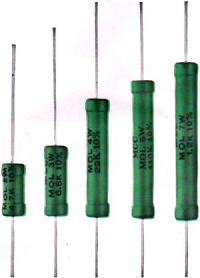|
January 1965 Electronics World
 Table
of Contents
Table
of Contents
Wax nostalgic about and learn from the history of early electronics. See articles
from
Electronics World, published May 1959
- December 1971. All copyrights hereby acknowledged.
|
Metal oxide resistors have
been around since the early 1960s. We take them for granted now, but prior to their
appearance on the market the mainstays of electronics resistance elements were carbon
composition and wirewound resistors. Carbon compound types are very inexpensive
and are acceptable for a wide range of applications, but they have a bad habit of
shifting value over time, particularly when subject to repeated heating and cooling
cycles. Wirewounds (WW) are a good alternative when cost and physical space are
not issues, but WW's can be tricky or even impossible to use when frequencies get
above a few tens of megahertz because of inductance limitations. Metal film
resistors exhibit much better long term stability than carbon composition types,
and can operate well at frequencies in the hundreds of megahertz while dissipating
a few watts of power. The television industry benefitted greatly, as this 1965-era
Mallory in Electronics World magazine advertisement points out.
What You Should Know About Film Resistors

Mallory Tips for Technicians
Mallory Distributor Products Company
P.O. Box 1558, Indianapolis, Ind. 46206
a division of P. R. Mallory & Co. Inc.

If you've been looking inside some of the recent model television sets, chances
are that you've noticed some unusual-looking resistors. Especially in the sizes
readily identifiable as under 10 watts. You'll probably find them in spots where
you're used to seeing small wirewound.
There's a good reason. These are metal oxide film resistors. And the reason they're
making such a hit is that they have as good stability and life as wire-wounds -
but they cost only about half as much in most values.

Typical stability test data: 10,000-hour load cycling test. Average
resistance change is less than 1%!
What's different about them?
First, they're made differently. A thin layer of tin oxide is evaporated onto
a high quality ceramic rod, at high temperatures. A spiral groove is then cut, by
a highly precise automatic machine, to produce a resistance path with the desired
ohmic value. Then the end connections are applied and the whole works gets a coating
of silicone finish. You can get a lot higher resistance values, size for size, than
with wirewounds, because you're not limited by the problems of winding hair-thin
wires. Top resistance for the 4, 5 and 7 watt sizes is 120,000 ohms; for 2 and 3
watts, 56,000 ohms. Standard tolerance is 10%.
Second, they behave differently. Their stability is really terrific, We've run
them with on-off load cycling for 10,000 hours and measured changes of t less than
1%. They'll take heavy brief overloads without damage, aren't bothered by humidity
or vibration. And they're noninductive up to 250 mc. The name to ask your Mallory
Distributor for is the MOL film resistor. He has them in 2, 3, 4, 5, and 7 watt
ratings, in popular resistance values. And when you need a higher wattage (up to
200 watts) ask him for Mallory vitreous enamel resistors - you can't beat them for
cool operation and stable life.
Posted October 9, 2023
(updated from original
post on 2/5/2015)
|











